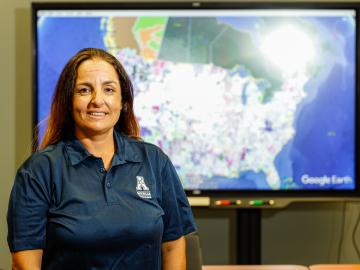
Filter News
Area of Research
- (-) Energy Science (49)
- Advanced Manufacturing (1)
- Biological Systems (1)
- Biology and Environment (55)
- Biology and Soft Matter (1)
- Computational Biology (2)
- Computational Engineering (2)
- Computer Science (6)
- Electricity and Smart Grid (2)
- Fusion and Fission (16)
- Fusion Energy (11)
- Isotopes (5)
- Materials (12)
- Materials for Computing (1)
- Mathematics (1)
- National Security (17)
- Neutron Science (13)
- Nuclear Science and Technology (8)
- Quantum information Science (1)
- Sensors and Controls (1)
- Supercomputing (47)
News Type
News Topics
- (-) Biomedical (3)
- (-) Grid (29)
- (-) Machine Learning (2)
- (-) Mercury (2)
- (-) Summit (2)
- 3-D Printing/Advanced Manufacturing (48)
- Advanced Reactors (2)
- Artificial Intelligence (3)
- Big Data (2)
- Bioenergy (12)
- Biology (6)
- Biotechnology (2)
- Buildings (27)
- Chemical Sciences (4)
- Clean Water (7)
- Composites (11)
- Computer Science (16)
- Coronavirus (8)
- Critical Materials (5)
- Cybersecurity (5)
- Energy Storage (44)
- Environment (35)
- Fossil Energy (1)
- High-Performance Computing (3)
- Hydropower (3)
- Materials (17)
- Materials Science (14)
- Mathematics (2)
- Microelectronics (1)
- Microscopy (4)
- Nanotechnology (3)
- National Security (1)
- Neutron Science (3)
- Nuclear Energy (3)
- Partnerships (4)
- Polymers (6)
- Quantum Science (1)
- Security (3)
- Simulation (2)
- Space Exploration (3)
- Statistics (1)
- Transportation (47)
Media Contacts

Researchers at Oak Ridge National Laboratory developed a method that uses machine learning to predict seasonal fire risk in Africa, where half of the world’s wildfire-related carbon emissions originate.

Ada Sedova’s journey to Oak Ridge National Laboratory has taken her on the path from pre-med studies in college to an accelerated graduate career in mathematics and biophysics and now to the intersection of computational science and biology
An international team of scientists found that rules governing plant growth hold true even at the edges of the world in the Arctic tundra.

Researchers at Oak Ridge National Laboratory demonstrated a 20-kilowatt bi-directional wireless charging system on a UPS plug-in hybrid electric delivery truck, advancing the technology to a larger class of vehicles and enabling a new energy storage method for fleet owners and their facilities.

Researchers at the Department of Energy’s Oak Ridge National Laboratory (ORNL) in late February demonstrated a 20-kilowatt bi-directional wireless charging system installed on a UPS medium-duty, plug-in hybrid electric delivery truck.

Researchers at ORNL demonstrated that sodium-ion batteries can serve as a low-cost, high performance substitute for rechargeable lithium-ion batteries commonly used in robotics, power tools, and grid-scale energy storage.

To better determine the potential energy cost savings among connected homes, researchers at Oak Ridge National Laboratory developed a computer simulation to more accurately compare energy use on similar weather days.

Isabelle Snyder calls faults as she sees them, whether it’s modeling operations for the nation’s power grid or officiating at the US Open Tennis Championships.

Sometimes solutions to the biggest problems can be found in the smallest details. The work of biochemist Alex Johs at Oak Ridge National Laboratory bears this out, as he focuses on understanding protein structures and molecular interactions to resolve complex global problems like the spread of mercury pollution in waterways and the food supply.

Scientists at Oak Ridge National Laboratory have developed a low-cost, printed, flexible sensor that can wrap around power cables to precisely monitor electrical loads from household appliances to support grid operations.


